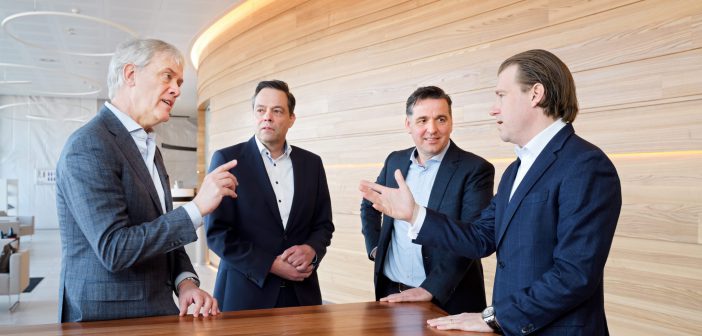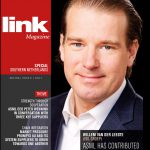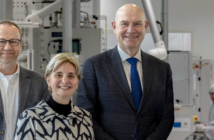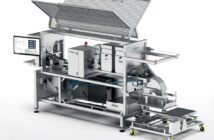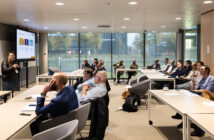ASML in Eindhoven is widely seen as one of the pearls of Dutch high-tech. Thanks to a unique product – a lithography machine – the company has managed to secure a very strong position in the chip manufacturing sector. An important factor in that success are the suppliers, quite a few of which are located in the immediate vicinity. This chain is rooted in a unique South Netherlands culture, characterised by, among other things, accessibility and transparency. A conversation with the CEOs of ASML, VDL and AAE and the COO of Neways.
- An important factor in ASML’s success are the suppliers, quite a few of which are located in the immediate vicinity.
- ‘It is precisely through working together in an integrated way, with suppliers who also participate in the development process, that ASML has been able to move up a gear.’
- And conversely, ASML has also contributed very much to the strength of the supply chain.’
- The South Netherland high-tech chain has a typical ‘Rhineland’ culture.
‘Willem’s office and mine are so close together we can almost wave to each other’
Before we begin, we are asked to confirm the time at which the interview will finish: CEO Peter Wennink of ASML has until exactly half past eleven. After that, he needs to leave posthaste for Schiphol to catch a flight to Barcelona for a meeting with a ‘major South Korean customer’ on the margins of the world’s biggest trade show and conference for the mobile phone industry, the Mobile World Congress (MWC19). A typical conversation with a customer, of a kind he has often, he makes clear: ‘It’s about the technological progress we are making, about the prospects for their next generation of chips. They want to use our EUV technology for that. This year, ASML will supply 30 EUV systems – extreme ultraviolet machines – each of which can produce 155 wafers per hour. ‘But these are machines that still need to be fully developed, in partnership with the customer. We will also be discussing the changes EUV will entail for the other steps in chip production. To this end, we also maintain close contacts with the OEMs of the other components of the chip production lines, in order to innovate together and so improve the reliability of the whole. We are talking about an ecosystem that is distributed across the world, with lots of parties in the US and Asia.’

Peter Wennink: ‘We can only deliver the required economies of scale if particular development work doesn’t have to be performed by two or three suppliers but only by one. Which means we only have to direct one party.’
Keeping European high-tech strong
A cybersecurity specialist at Clingendael recently told the Financieele Dagblad that ASML ‘is attacked more than anyone else’. ‘Whether that is strictly true I don’t know’, says Wennink, ‘but the fact is that we are subject to online attacks, like every major technology firm. The same goes for our key suppliers, although they may not know it.’
A few of those suppliers are also present at the discussion. One of them, Adrie van Bragt, COO of electronics manufacturer Neways, is aware that his company is also regularly approached by parties from Asia about the technology they make for ASML. ‘Naturally, we always refuse those kinds of requests, for information about the type of PCBAs (printed circuit board assemblies, ed.) we manufacture for ASML. And we report them to ASML, as agreed. But it does show that we are on the radar of the Chinese. That’s why we need to avoid a situation in which we can only buy our bare PCBs from China. We must make sure we keep large parts of this technology in Europe. For that reason, purchasing in Europe is also part of our policy, and we don’t just look at price. In order to ensure that the Chinese don’t have that technology entirely in their hands in the future’, says Van Bragt. Wennink nods in agreement: ‘As part of that, the Southern Netherlands ecosystem also needs contribute to keeping European high-tech industry strong, by growing and investing here.’
Strengthening each other
The regional ecosystem is at the root of the success that the chip machine manufacturer has built up over recent years, believes Willem van der Leegte, CEO of VDL Groep, developer and integrator of the wafer handler and the vacuum chamber (‘vessel’) for the EUV machine, respectively. ‘It is precisely by working together in an integrated way, with suppliers who are also part of the development process, that ASML has been able to move up a gear and acquire its position as the global market leader in chip production machines, the one that calls the shots. But conversely, ASML has also contributed very much to the strength of the supply chain.’
‘Changing the DNA of our engineers is not easy’
‘What the suppliers deliver for us in this region is absolutely world class – for example, the work VDL does for us in the field of mechatronics. As a result, we were able to move up a gear and get ahead of the rest’, Wennink observes – to an audience made up of three of his core suppliers. Besides VDL and Neways there is also AAE, responsible for the development and production of several modules in the vessel. AAE is represented by CEO Frank Mulders.
Accessible
There are six of us at the table, including the journalist and the VDL press officer, in the office of our host Willem van der Leegte, to jointly reflect on the strengths and challenges for the South Netherlands ecosystem. During the interview, Wennink lives up to his role as chain director and frequently takes the lead in answering questions. ‘The integrated nature of the chain here has its origins in the Philips family. The foundations for much of the knowledge we still draw on today were laid by them. The open manner in which we are able work together with our suppliers here is unique. Of course, we also have our partners in Taiwan and Singapore, but due to the time difference and the distance, the character of those collaborations is bound to be different. Whereas Willem’s office and mine are so close together we can almost wave to each other.’
To illustrate that bond, the ASML man points to the way they together solved the problems caused by a major fire in early December at Prodrive, another big supplier based in the region. ‘Immediately after the fire, we started working together intensively in order to solve the problems as quickly as possible. That has everything to do with the accessible way of working together here. It’s about trusting the supplier and helping them take the lead, while still providing assistance. Elsewhere in the world, the consequences of such a large-scale incident would have been much more drastic.’
Trust
You also see that close bond now that the time has come to evaluate the fire, adds Willem van der Leegte: ‘For example, compartmentalising has proved very important: make sure you locate your components and processes in as many different places as possible, separated by fire barriers. We are going to draw lessons from that ourselves and reconfigure our development and production areas. That’s very important, because only if a customer has faith that their technology is in good hands can they permit themselves single sourcing of unique products.’
‘We can only deliver the required economies of scale’, adds Wennink, ‘if particular development work doesn’t have to be performed by two or three suppliers but only by one. Which means we only have to direct one party. One party which, by definition, only provides a relatively small part of our technology requirement, in order to retain a healthy mutual dependence.’
Going out for a beer
The Southern Netherlands high-tech chain has a typical ‘Rhineland’ culture, which prioritises not only the interests of shareholders but equally those of customers, suppliers, employees and society, plus government and research institutes. Mulders: ‘This transparent way of working together, less legalistic, is typically Western European. You see it Germany too. It is a model that people in the US and Asia are looking at with interest too. But adopting that model will be difficult for firms elsewhere in the world. We are talking about a deeply rooted culture. There, they are more focused on achieving short-term results.’
‘A culture is always highly regionally-based. The culture in Amsterdam, but also in the East of the Netherlands, is already different to the culture here’, says Wennink, who has many relatives in Overijssel. They do understand loyalty to the company and how to work together, but here we are happy to express our dependence on one another. ‘And we value a good atmosphere. We enjoy working together and go out for a beer together’, chimes in Van der Leegte in his Brabant baritone.
More open
Only in this way can the Eindhoven ecosystem bring down the cost of non quality sufficiently for ASML’s customers. Wennink: ‘If our fully developed Immersion machines have an outage for just one day at a customer’s site, that can easily cost them two million dollars in lost revenue. Then I get angry phone calls or e-mails from my customers: ‘Why has this happened and how are you going to solve it?’ Escalations like these still take place frequently. Even if customers don’t always recognise the fact, our engineers are not all-round geniuses. They are people who are above all focused on developing new things. They come to me with lots more ideas than I have R&D budget for, even though I have 1.9 billion to spend annually. So, it’s better if we focus exclusively on the functional design of our technology.’ ASML wants to devolve the extended development and manufacturability of that technology to its suppliers far more than is currently the case. ‘We need to become more open towards the chain about that and also make room for it in our R&D budget. But changing the DNA of our engineers will not be easy’, says the CEO, alluding to one of his missions.
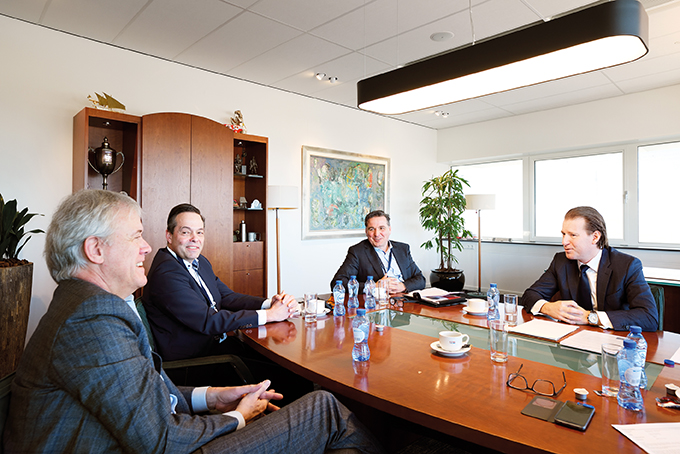
‘We want to devolve the development and manufacturability of our technology to our suppliers much more than we do now. We need to become more open towards the chain about that and make room for it in our R&D budget’, believes ASML CEO Peter Wennink, left in the photo. Beside him are Adrie van Bragt (COO Neways), Frank Mulders (CEO AAE) and Willem van der Leegte (CEO VDL). Photos: Bart van Overbeeke.
Adrie van Bragt weighs in: ‘It demands of us that we demonstrate, for example, that we are best-placed to select the electronics components ourselves and not – as is currently often the case – having to use what ASML lays down. We need to show that we can do the onward development of our PCBAs for ASML independently and better. Then we will really be adding value for ASML, and that requires that we keep on investing in partnership and mutual trust.’
Linking together
In truth, Wennink’s mission consists of ‘linking together development and production’. A task also facing the suppliers represented here, at their own level. Mulders: ‘Developing without having our own product is not in our DNA as a supplier, but that is what we are aiming to do. We want to form a group of free thinkers who can more easily talk the same language as the engineers at ASML.’ ‘In order to work towards an ecosystem’, chips in Van der Leegte, ‘that is all about invented by us, not invented by me.’ Mulders of AAE: ‘Precisely in order to bring together developers and the production department, when we refurbished our buildings in Helmond, we installed as many glass walls as possible. So that the engineers can see the production lines directly, and vice versa. That really helps.’
That brings the discussion to the issue of the labour market. Mulders points out that the level at which his people are working is different to that of the engineers and constructors at ASML. That fact somewhat takes the edge off the problem, says Wennink. ‘Ninety percent of our people are university-trained, a good proportion have PhDs; fewer than ten percent do not have a university background. Among our suppliers, that distribution is different, so you might say we are not fishing in the same pond. Our suppliers employ the master craftsmen, ‘the golden hands’ we so badly need in the chain. They are becoming ever scarcer, too.
‘And we value being able to enjoy working together and going out for a beer together’
But at the same time, the aim is for ASML and its chain to converge in terms of knowledge levels. Which makes the existing shortage in the labour market real and urgent, says Van der Leegte: ‘The region’s attractiveness to knowledge workers, foreign as well as Dutch, is not great right now. The housing deficit is huge, which means accommodation costs are very high. Increasing the attractiveness of this region deserves more financial support from the government – particularly when you are aware that, as I have often pointed out, Amsterdam receives 195 euros per person in municipal funding from central government whereas here in Eindhoven we get 1.53 euros per person. Last year the cabinet did earmark 130 million euros to enhance the region’s attractiveness in terms of accommodation and the living environment, but it was a one-off grant and had to be co-financed. That kind of support ought to be ongoing.’
Improved efficiency
When prompted, Peter Wennink puts forward another solution: designing processes more efficiently so that scaling up does not necessarily require additional people in the same proportion. ‘Under the name Our New Enterprise, ONE, we are working on a business process re-design aimed at achieving substantially improved efficiency by 2025. The entire process from placing an order right up to delivery still dates from a time when we were a much smaller-scale business. It’s full of inefficiencies.’ The solution lies not just in information technology. ‘In the coming years, we will be putting a lot of money and energy into a far more integrated, software-based, standardised backbone. That will replace our current unique in-house-programmed ERP system which has continued to expand over the years. ‘But’, he stresses, ‘more important to the business process is properly laying down and implementing how our people can work together efficiently. That can be done by means of standard processes, with standard IT as support. Configuration management, for example, is something we can do using standard software. Although we create unique products, we are otherwise a regular company that can work with standard IT. ‘Standardise!’, is my mantra as CEO.’
Role of the CEO
With three CEOs and one COO sat around the table, it is appropriate to ask about the role of the top boss within that integrated chain partnership. Wennink immediately downplays his significance: ‘The CEO is the most overrated role’, he says. It is above all one of being a ‘connector’. ‘Someone who is able to create a good team. A condition is that, as a CEO, you completely believe in your strategy, because people have a sixth sense for that.’ Mulders concurs: ‘The CEO is like a conductor who, above all, must be able to get the top musicians in his orchestra to work together well.’ ‘He must bring together the different disciplines, the development department and the factory first and foremost, and connect them with one another. That requires an atmosphere in which people feel safe enough to be critical towards each other’, says Neways man Van Bragt. ‘Industrial people like talking about the facts, the nitty gritty, but the CEO also needs to put a lot of effort into maintaining the people side’, Wennink observes.
Ensuring accessibility. And that is so characteristic of this region, notes Van der Leegte. It is no coincidence that – like his predecessor and father Wim – he has his office in a relatively small building, so that you can practically walk through the front door and straight into his office. ‘That way, you create the accessibility that makes this Brabant ecosystem so unique in the world.’
Margins
Finally, the journalist brings up what he calls a ‘less cosy topic’: dividing up the margin within the chain. ‘Why do you think that is a less cosy topic?’, Frank Mulders shoots back. ‘When it comes to dividing up the cake, things often get less cosy, because everyone wants the biggest piece’, the Link man suggests. However, no one takes the bait. ‘Trust in your partner is a mathematical function’, begins Wennink: ‘Competency times reliability times transparency, divided by self-interest. If the self-interest gets too big, confidence goes down. Self-interest is a matter of managing risk and reward-sharing. The distribution has to reflect the value that a supplier delivers. If it delivers more value, it is entitled to a bigger margin and it should get it. That is why we are very transparent towards our customer Intel, for example, about our own cost structure and margin.’ Mulders has his own definition: ‘Margins are not divided; by definition, you get the margin you deserve.’ ‘That’s why the margin a vital supplier like Zeiss makes is almost as good as our own, much higher than the margin of the built to print supplier’, points out Wennink. ‘Which is why I tell our purchasing department to also consider the quality of the collaboration between us and the supplier.’
Explaining clearly
Van der Leegte adds, with characteristic matter-of-factness: ‘We are proud of our long-term relationship with ASML. Of course, we discuss the margins and we explain our position clearly. If you carry out development work for the customer, everyone understands that you cannot bear the cost if things go wrong but not share in the extra revenue if things go well. You wouldn’t last long as a supplier if you did. If you explain that clearly, your partner will understand. Having customers like ASML is very good for our image. Plus, we learn from customers like that. Incidentally, the same is true for them.’

